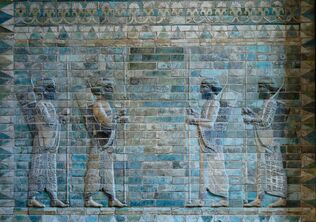(Created page with "thumb|316px|Two symmetrical lines of archers from the Palace of Darius I (Achaemenid Persian Period 550-330 BCE). Write the first paragraph of your page her...") |
No edit summary |
||
| Line 1: | Line 1: | ||
| − | [[File:NE3.jpg|thumb|316px| |
+ | [[File:NE3.jpg|thumb|316px|The Frieze of Archers from the Palace of Darius I (Achaemenid Persian Period 550-330 BCE). ]] |
Write the first paragraph of your page here. |
Write the first paragraph of your page here. |
||
==Brief Introduction == |
==Brief Introduction == |
||
| − | Two lines of marching Persian soldiers |
+ | Two lines of marching Persian soldiers from Susa, Iran made from polychrome glazed siliceous brick and excavated from the remains of the Palace of Darius I. The decrative frieze measures 4.75 meters by 3.75 meters, and was made around 500-510 BCE. It is currently in the Near Eastern Antiquities section of the Lourve Museum in Paris, France. |
==Technical Evaluation == |
==Technical Evaluation == |
||
| + | This frieze shows two symmetrical lines of Persian soilders marching. These soldiers, that may have been the Persian "immortals", have both hands holding the spear infront of them with a bow and quiver around the backs. They are dressed in long Persian robes, are bearded and have thick curly hair massed at the nape of the neck. |
||
| + | The Frieze of Archers was most likely inspired by the Processional Way in Babylon, built by Nebuchadnezar (604-562 BCE) but, was created using a different teqnuique. The bricks used in this frieze are molded from a quart-based body and are rectangular on the decrative side but taper in the back. This would allow the builders to have room for mortor when all of the rectangular faces were lined up against one another. These friezes have low relief backgrounds and are colors of green, white, yellow and brown. It was Darius I (558-486 BCE) who had the palace contructed in Susa and from Darius' building inscription at Susa he tells that it was Babylonian people who worked on the glazed bricks. Although the exact location is still unknown due to peices and fragments have been found all around and in the apadana the strong hypothesis is that Frieze of Archers covered the exterior walls to the apadana. |
||
| − | The Frieze of Archers was most likely inspired by the Processional Way in Babylon but |
||
| + | |||
| + | <p style="text-align:left;">While the first excavation of Susa and the palace were made by British archeologist W.K. Loftus in 1851 it was in 1884 that Marcel Dieulafoy, a French archeologist, whose work allowed the Frieze of Archers to find its way to its current home in Paris, France at the Lourve Museum </p> |
||
| + | [[Category:Local Historical Importance]] |
||
| + | [[Category:World-Historical Significance]] |
||
| + | [[Category:Bibliography]] |
||
Revision as of 06:10, 23 April 2013

The Frieze of Archers from the Palace of Darius I (Achaemenid Persian Period 550-330 BCE).
Write the first paragraph of your page here.
Brief Introduction
Two lines of marching Persian soldiers from Susa, Iran made from polychrome glazed siliceous brick and excavated from the remains of the Palace of Darius I. The decrative frieze measures 4.75 meters by 3.75 meters, and was made around 500-510 BCE. It is currently in the Near Eastern Antiquities section of the Lourve Museum in Paris, France.
Technical Evaluation
This frieze shows two symmetrical lines of Persian soilders marching. These soldiers, that may have been the Persian "immortals", have both hands holding the spear infront of them with a bow and quiver around the backs. They are dressed in long Persian robes, are bearded and have thick curly hair massed at the nape of the neck.
The Frieze of Archers was most likely inspired by the Processional Way in Babylon, built by Nebuchadnezar (604-562 BCE) but, was created using a different teqnuique. The bricks used in this frieze are molded from a quart-based body and are rectangular on the decrative side but taper in the back. This would allow the builders to have room for mortor when all of the rectangular faces were lined up against one another. These friezes have low relief backgrounds and are colors of green, white, yellow and brown. It was Darius I (558-486 BCE) who had the palace contructed in Susa and from Darius' building inscription at Susa he tells that it was Babylonian people who worked on the glazed bricks. Although the exact location is still unknown due to peices and fragments have been found all around and in the apadana the strong hypothesis is that Frieze of Archers covered the exterior walls to the apadana.
While the first excavation of Susa and the palace were made by British archeologist W.K. Loftus in 1851 it was in 1884 that Marcel Dieulafoy, a French archeologist, whose work allowed the Frieze of Archers to find its way to its current home in Paris, France at the Lourve Museum